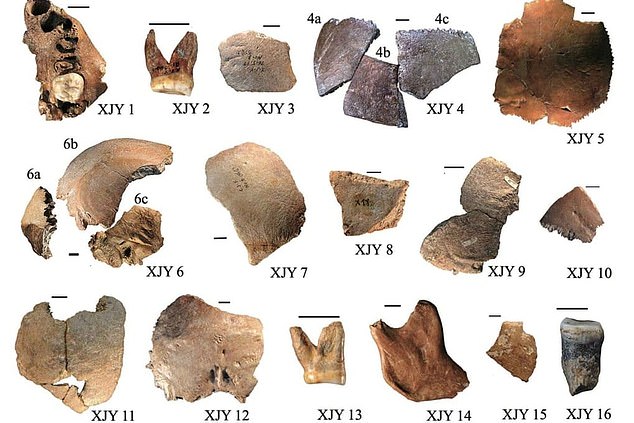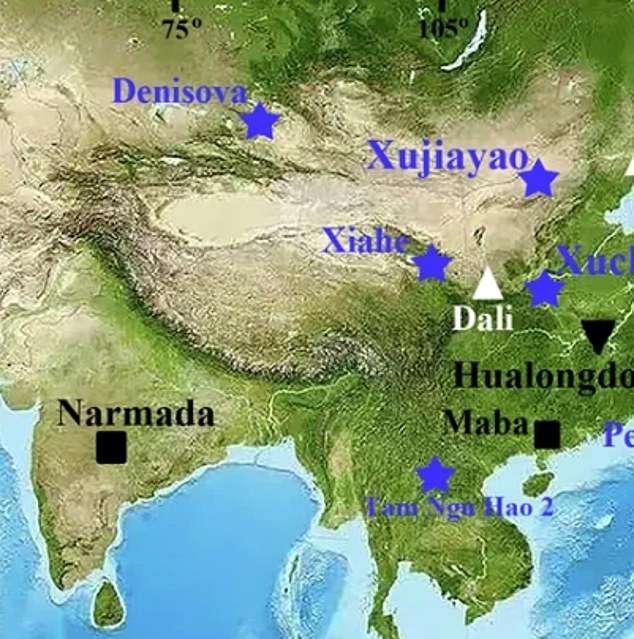Scientists discover new human species with an unusual physical feature that went extinct 200,000 years ago
Scientists have discovered a new human species that went extinct in China 200,000 years ago.
They found the remains of 16 individuals, with large heads, broad skulls and enormous teeth.
Their head sizes, which were larger than those of Neanderthals and Homo sapiens, led the team to name a new prehistoric species, called Homo juluensis.
The fossilized remains were found alongside thousands of artifacts, stone tools and animal bones that revealed more about their lives, such as hunters making clothes from animal skins.
Researchers believe the species lived in small groups that likely disappeared when modern humans began migrating to Europe and Asia 120,000 years ago.
Homo juluensis lived during a dramatic climate change that saw an ice age, bringing in cooler and drier weather.
Because Homo juluensis lived in small groups, they were vulnerable to being trapped in severe weather conditions that could have led to their demise.
“This is part of the reason why the population density of Homo juluensis is probably never as high as it was when modern humans left Africa… in greater numbers,” Bae told the Post.
‘They have genetically overwhelmed native populations such as Neanderthalensis and Juluensis.’
Numerous teeth were found at the site, which scientists discovered were much larger than those of other human species. The size suggested that they were hunters who enjoyed only meat

They found the remains of 16 individuals, with large heads, broad skulls and enormous teeth. Their head sizes, which were larger than those of Neanderthals and Homo sapiens, led the team to name a new prehistoric species, called Homo juluensis.
“The East Asian record pushes us to recognize how complex human evolution in general is and really forces us to revise and reconsider our interpretations of various evolutionary models to better fit the growing fossil record,” co told study author Christopher Bae. South China morning mail.
Researchers from the University of Honolulu and the Chinese Academy of Sciences reported that the Homo juluensis skulls measured between 103 and 109 cubic centimeters in size.
This was compared to the skulls of Neanderthals which measured 88 cubic centimeters and Homo sapiens which measured 82 cubic centimeters.
However, Bae cautioned that the size difference does not necessarily mean that the ancient species had higher intelligence than modern humans.
The researchers compared the fossils with those of Neanderthals and Denisovans – whose bone fragments were discovered in a South Siberian cave in 2008.
Their findings led researchers to believe they were unrelated to Neanderthals, who lived in Europe and Asia until about 40,000 years ago.
However, they noted that the Homo juluensis species showed similarities to the Denisovans due to their matching teeth features.
‘One of the things that always stood out about the Denisovan molars was that they were quite large. The molars of Xujiayao of our type specimen are also quite large,” Bae said.
They looked at a comparison of the biting surfaces, where the lower and upper teeth came into contact during chewing and that the surface of the molars was ‘almost exactly the same’.
Using dating analysis, the researchers argued that Denisova is not its own species, but rather the name of a general population of ancient humans, adding that it “probably belongs to Homo juluensis based on their similarities.”

Researchers have linked fossils found in China in the 1970s to a new human species called homo juluensis
Bae reported that the stone tools, artifacts and animal bones indicated that Homo juluensis lived on and processed wild horses at the Xujiayao site where their fossils were found.
They hunted the horses as a group and used their entire bodies to sustain themselves, including consuming the meat, marrow and cartilage and using the skins to make clothing to protect them from the brutal winters.
The study, published in the journal Naturesaid the new species likely arose as a result of a combination of crossing their genetics with Homo sapiens and migrating to new locations during the Late Quaternary period – which began 300,000 years ago.
“Recent research initiatives in China and broader East Asia clearly demonstrate that multiple hominin lineages were present during the Late Quaternary,” the study said.
This period was categorized by major shifts in climate change that caused recurring ice ages that caused the extinction of ancient human species.
The study’s authors stated that the “diversity among… human fossils from East Asia is greater than we expected.”
They added that their findings have given researchers “a greater appreciation of the degree of complexity present” in the region.
